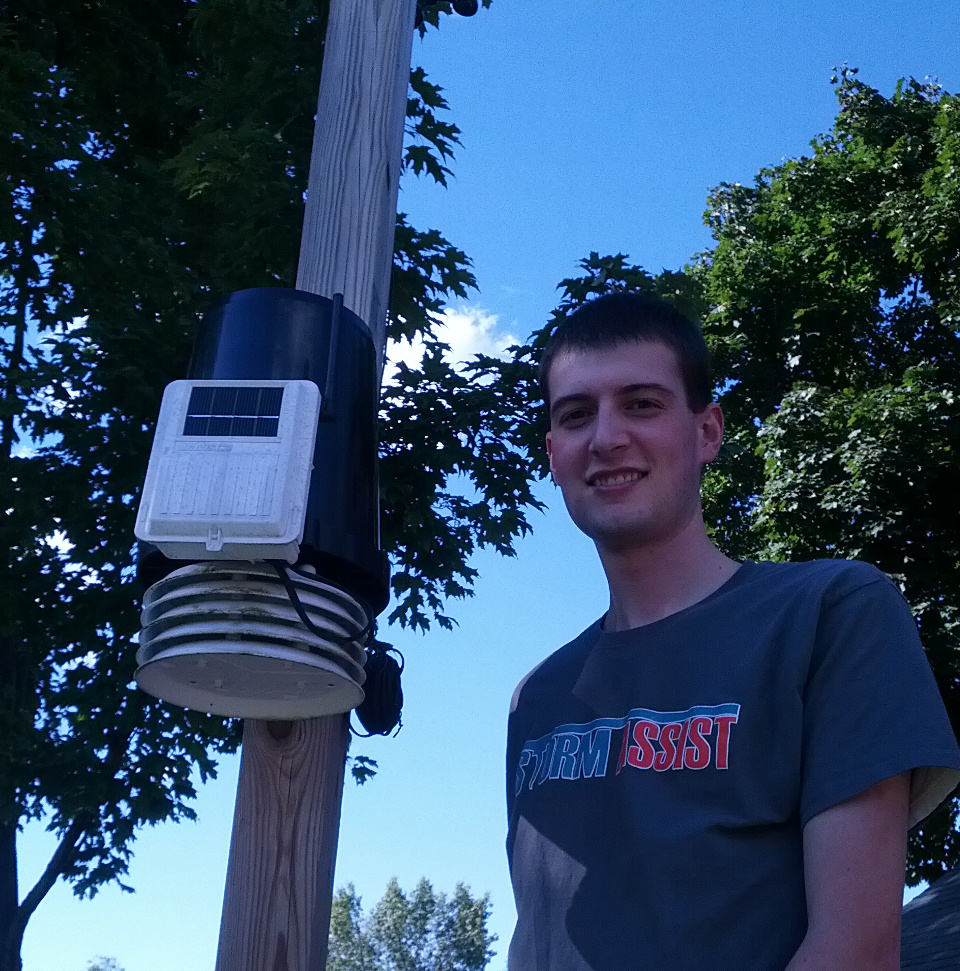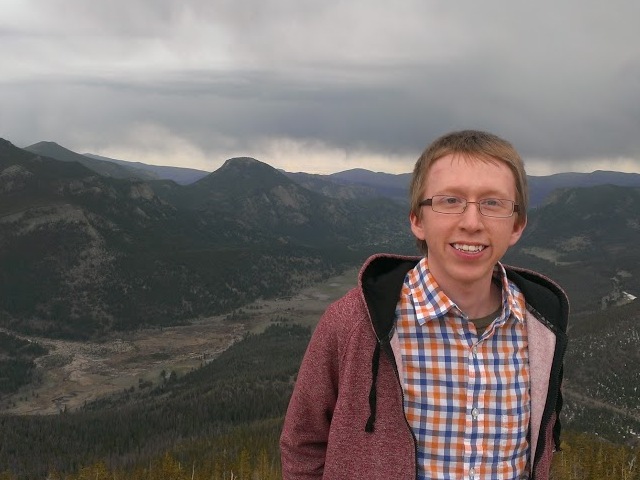Research Team
    |
Dr. Benjamin Lintner (PI) Research
project: El Niño/Southern
Oscillation (ENSO) teleconnections over
tropical South America
Max Pike (Ph.D. Student) Research
project: Application of
self-organizing maps and k-means
clustering to tropical and South Pacific
rainfall in observations and CMIP5 models
Sarah Tannenbaum (Ph.D. Student) Research
project: Land-atmosphere
coupling in the North American monsoon
Chi Zhang (Master's Student) Research
project: Controls on the
Meiyu-Baiu Front
Lauren Hill-Beaton (Undergraduate) Research project: Analysis of tropical cyclone genesis potential |
Group Alumni
   |
Dr. Alexis Berg (Postdoctoral Associate) Current
Position: Postdoctoral
Associate
Princeton University Dr. Damianos Mantsis (Postdoctoral Associate) Current
Position: Postdoctoral
Associate
Climate Change Research Centre University of New South Wales Matthew Niznik (Ph.D. Student) Current position: Application Developer Rutgers University-Information Technology at Continuing Studies (ITaCS) Lalitha Kommajosyula (M.S. Student) Donna Brunnquell (2016 RiSE Program Student) Kristina Mazur (Undergraduate) Andrew Rohrman (Undergraduate) Alyssa Stansfield (Undergraduate) Current
Position: PhD Student,
School of Marine and Atmospheric
Sciences, Stony Brook University
Ayzha Ward (2014 RiSE Program Student) |
Note:
Links to article pdfs are provided below. Access
to some may be restricted.
· Lintner, B.R., and J.D. Neelin, 2010: Tropical South America/Atlantic sector convective margins and their relationship to low-level inflow. J. Clim., 23, 2671—2685. PDF @ AMS
· Lintner, B.R., and J.D. Neelin, 2009: Soil moisture impacts on convective margins. J. Hydrometeor., 10, 1026—1039. PDF @ AMS
· Lintner, B.R., and J.D. Neelin, 2008: Eastern margin variability of the South Pacific Convergence Zone. Geophys. Res. Lett., 35, L16701, doi:10.1029/2008GL034298. PDF @ WILEY
· Lintner, B.R., and J.D. Neelin, 2007: A prototype for convective margin shifts. Geophys. Res. Lett., 34, L05812, doi:10.1029/2006GL027305. PDF @ WILEY
· Lintner, B.R., B. Langenbrunner, J.D. Neelin, B.T. Anderson, M.J. Niznik, G. Li, and S.-P. Xie, 2016: Characterizing CMIP5 model spread in simulated rainfall in the Pacific Intertropical Convergence and South Pacific Convergence Zones. J. Geophys. Res. Atmos., 121, 11,590—11,607, doi:10.1002/2016JD025284. [Support from NSF-AGS-1312865] PDF @ WILEY
· Niznik, M.J.*, B.R. Lintner, A.J. Matthews, and M.J. Widlansky, 2015: The role of tropical-extratropical interaction and synoptic variability in maintaining the South Pacific Convergence Zone in CMIP5 models. J. Clim., 28, 3353—3374, doi:10.1175/JCLI-D-14-00527.1. [Support from NSF-AGS-1312865] PDF @ AMS Read highlights from this article.
· Niznik, M.J.*, and B.R. Lintner, 2013: Circulation, moisture, and precipitation relationships along the South Pacific Convergence Zone in reanalyses and CMIP5 models. J. Clim., 26, 10174—10192, doi:10.1175/JCLI-D-13-00263.1. [Support from NSF-AGS-1312865] PDF @ AMS Read highlights from this article.
· Mantsis, D.F.*, B.R. Lintner, A.J. Broccoli, and M. Khodri, 2013: Mechanisms of Mid-Holocene precipitation change in the South Pacific Convergence Zone. J. Clim., 26, 6937—6953, doi:10.1175/JCLI-D-12-00674.1. [Support from NSF-AGS-1103209] PDF @ AMS Read highlights from this article.
· Park, H.-S., J.C.H. Chiang, B.R. Lintner, and G.J. Zhang, 2010: The delayed effect of major El Niño events on Indian monsoon rainfall. J. Clim., 23, 932—946. PDF @ AMS
· Lintner, B.R., and J.C.H. Chiang, 2007: Adjustment of the remote tropical climate to El Niño conditions. J. Clim., 20, 2544—2557, doi:10.1175/JCLI4138.1. PDF @ AMS
· Lintner, B.R., and J.C.H. Chiang, 2005: Reorganization of tropical climate during El Niño: A weak temperature gradient approach. J. Clim., 18, 5312—5329, doi:10.1175/JCLI3580.1. PDF @ AMS
· Chiang, J.C.H., and B.R. Lintner, 2005: Mechanisms of remote tropical surface warming during El Niño. J. Clim., 18, 4130—4149, doi:10.1175/JCLI3529.1. PDF @ AMS
Amazon Hydroclimate
In current DOE-funded collaboration
[DE-SC0011069] with Jung-Eun Lee (Brown University),
Pierre Gentine, and Joe Berry (Carnegie Institution
for Science) as well as collaborators in Brazil, we
are evaluating how vegetation processes impact
precipitation seasonality and variability in the
Amazon.
· Lintner, B.R., D.K. Adams, K.A. Schiro, A.M. Stansfield*, A. Amorim Rocha, and J.D. Neelin, 2017: Relationships among climatological vertical moisture structure, column water vapor, and precipitation over the Central Amazon in observations and CMIP5 models. Geophys. Res. Lett., 44 , 1981–1989, doi:10.1002/2016GL071923. [Support from DE-SC0011069 and NSF-AGS-1505198] PDF @ WILEY
· Schiro, K.A., J.D. Neelin, D.K. Adams, and B.R. Lintner, 2016: Deep convection and column water vapor over tropical land vs. tropical ocean: A comparison between the Amazon and tropical western Pacific. J. Atmos. Sci. 73, 4043—4063, doi:10.1175/JAS-D-16-0119.1. [Support from DE-SC0011069 and NSF-AGS-1505198] PDF @ AMS
· Lee, J.-E., B.R. Lintner, C.K. Boyce, and P.J. Lawrence, 2011: Land use change exacerbates tropical South American drought by sea surface temperature variability. Geophys Res. Lett. 38, L19706, doi:10.1029/2011GL049066. [Support from NSF-AGS-1035986] PDF @ WILEY
· Berg, A.M, B.R. Lintner, K.L. Findell, and A. Giannini, 2017: Uncertain soil moisture feedbacks in model projections of Sahel precipitation. Geophys. Res. Lett., (in revision).
· Findell, K.L., A. Berg, P. Gentine, J.P. Krasting, B.R. Lintner, S. Malyshev, J.A. Santanello, and S. Shevliakova, 2017: The impact of historical land use/land cover change on regional climate extremes. Nature Communications, (revised).
· Berg, A.M, B.R. Lintner, K.L. Findell, and A. Giannini, 2017: Soil moisture influence on seasonality and large-scale circulation in simulations of the West African monsoon. J. Clim., 30, 2295—2317, doi:10.1175/JCLI-D-0877.1.
· Berg, A.M, K.L. Findell, B.R. Lintner, A. Giannini, S.I. Seneviratne, B. van den Hurk, R. Lorenz, A. Pitman, S. Hagemann, A. Meier, F. Cheruy, A. Ducharne, S. Malyshev, and P.C.D. Milly, 2016: Land-atmosphere feedbacks amplify aridity increase over land under global warming. Nature Climate Change, 6, 869—874, doi:10.1038/nclimate3029. [Support from NSF-AGS-1505198] PDF @ NATURE Read the Rutgers EOAS news item about this article.
· Findell, K.L., P. Gentine, B.R. Lintner, and B. Guillod, 2015: Data length requirements for observational estimates of land-atmosphere coupling strength. J. Hydrometeor, 16, doi:10.1175/JHM-D-14-0131.1. [Support from NSF-AGS-1035986] PDF @ AMS
· Lintner, B.R., P. Gentine, K.L. Findell, and G.D. Salvucci, 2015: The Budyko and complementary relationships in an idealized model of large-scale land-atmosphere coupling. Hydrol. Earth Sys. Sci., 19, 2119—2131, doi:10.5194/hess-19-2119-2015. [Support from NSF-AGS-1035986] PDF @ HESS
· Berg, A.M.*, B.R. Lintner, K.L. Findell, S.I. Seneviratne, B. van den Hurk, F. Cheruy, S. Hagemann, D.M. Lawrence, S. Malyshev, A. Meier, and P. Gentine, 2015: Interannual coupling between summertime surface temperature and precipitation: Processes and implications for climate change. J. Clim., 28, 1308—1328, doi:10.1175/JCLI-D-14-00324.1. [Support from NSF-AGS-1035986] PDF @ AMS
· Alter, R.E., Y. Fan, B.R. Lintner, and C.P. Weaver, 2015: Observational evidence for the influence of irrigation on summer precipitation intensity and totals in the Midwestern US. J. Hydrometeor., 16, 1717—1735, doi:10.1175/JHM-D-140115.1. PDF @ AMS
· Berg, A.M.*, B.R. Lintner, K.L. Findell, S. Malyshev, P.C. Loikith, and P. Gentine, 2014: Impact of soil moisture-atmosphere interactions on surface temperature distributions. J. Clim., 27, 7976—7993, doi:10.1175/JCLI-D-13-00591.1. [Support from NSF-AGS-1035986] PDF @ AMS
· Guillod, B.P, B. Orlowsky, D. Miralles, A.J. Teuling, P. Blanken, N. Buchmann, P. Ciais, M. Ek, K.L. Findell, P. Gentine, B.R. Lintner, R.L. Scott, B. van den Hurk, and S.I. Seneviratne, 2014: Land surface controls on afternoon precipitation diagnosed from observational data: Uncertainties and confounding factors. Atm. Chem. Phys., 14, 8343—8367, doi:5194/acp-14-8343-2014. PDF @ ACP
· Rochetin, N., B.R. Lintner, K.L. Findell, A.H. Sobel, and P. Gentine, 2014: Radiative convective equilibrium over a land surface. J. Clim., 27, 8611—8629. PDF @ AMS
· Aires, F., K.L. Findell, P. Gentine, B.R. Lintner, and C. Kerr, 2013: Neural network-based sensitivity analysis of summertime convection over the continental US. J. Clim., 27, 1958—1979, doi:10.1175/JCLI-D-13-00161.1 [Support from NSF-AGS-1035986] PDF @ AMS
· Berg, A.M.*, K.L. Findell, B.R. Lintner, P. Gentine, and C. Kerr, 2013: Precipitation sensitivity to surface heat fluxes over North America in reanalysis and models. J. Hydrometeor., 14, 722—743, doi:10.1175/JHM-D-12-0111.1 [Support from NSF-AGS-1035986] PDF @ AMS
· Su, H., R.E. Dickinson, K.L. Findell, and B.R. Lintner, 2013: How are spring snow conditions in central Canada related to early warm season precipitation? J. Hydrometeor., 14, 787—807, doi:10.1175/JHM-D-12-029.1 [Support from NSF-AGS-1035986] PDF @ AMS
· Lintner, B.R., P. Gentine, K.L. Findell, F. D'Andrea, A.H. Sobel, and G.D. Salvucci, 2013: An idealized prototype for large-scale land-atmosphere coupling. J. Clim., 26, 2379—2389, doi:10.1175/JCLI-D-11-000561.1 [Support from NSF-AGS-1035986] PDF @ AMS
· Gentine, P., P. D'Odorico, B.R. Lintner, G. Sivandran, and G.D. Salvucci, 2012: Interdependence of climate, soil, and vegetation as constrained by the Budyko curve. Geophys. Res. Lett, 39, L19404, doi:10.1029/2012GL053492. PDF @ WILEY
· Lee, J.-E., B.R. Lintner, J.D. Neelin, X. Jiang, P. Gentine, C.K. Boyce, J.B. Fisher, J.T. Perron, T.L. Kubar, J. Lee, and J. Worden, 2012: Reduction of tropical land region precipitation variability via transpiration. Geophys. Res. Lett., 39, L19704, doi:10.1029/2012GL053417. [Support from NSF-AGS-1035986] PDF @ WILEY
· Gentine, P., T.J. Troy, B.R. Lintner, and K.L. Findell, 2012: Scaling in surface hydrology. J. Contemp. Water Res. Education, 47, 28—40. [Support from NSF-AGS-1035986]
· Findell, K.L., P. Gentine, B.R. Lintner, and C. Kerr, 2011: Probability of afternoon precipitation in eastern US and Mexico enhanced by high evaporation. Nature Geosci., 4, 434—439, doi:10.1038/ngeo1174. [Support from NSF-AGS-1035986] PDF @ NATURE Read the GFDL web highlight of this article.
Methodologies for analyzing climate data
The distribution of water vapor in the atmosphere has
important implications climate processes such as radiative
transfer and deep convection. Research in this area
has emphasized relationships between tropospheric water
vapor or trace constituents (e.g., CO), deep convection, and
the vertical and horizontal characteristics of the flow, in
particular how the statistical properties of the pdfs (e.g.,
longer-than-Gaussian "tails") reflect underlying convective
or transport processes. Two other current areas of
interest include application of empirical decomposition
techniques to characterize spread in model ensembles and
application of self-organizing maps to identify large-scale
meteorological patterns associated with extreme events, the
latter in collaboration with Paul Loikith (Portland State
University).
· Loikith, P.C., B.R. Lintner, and A. Sweeney 2017: Characterizing large-scale meteorological patterns and associated temperature and precipitation extremes over the Northwestern United States using self-organizing maps. J. Clim., (in press), doi:10.1175/JCLI-D-16-0670.1.
· Langenbrunner, B., J.D. Neelin, B.R. Lintner, and B.T. Anderson, 2015: Patterns of precipitation change and climatological uncertainty among CMIP5 models, with a focus on the midlatitude Pacific storm track. J. Clim., 28, 7857—7872, doi:10.1175/JCLI-D-14-00800.1. [Support from NSF-AGS-1312865] PDF @ AMS
· Loikith, P.C., D.E. Waliser, H. Lee, J.D. Neelin, B.R. Lintner, S. McGinnis, L.O. Mearns, and J. Kim, 2015: Evaluation of the ability of the NARCCAP ensemble of regional climate simulations to represent large-scale meteorological patterns associated with extreme temperatures. Clim. Dyn., 45, 3257—3274, doi:10.1007/s00382-015-2537-x. PDF @ SPRINGER
· Anderson, B.T., B.R. Lintner, B. Langenbrunner, J.D. Neelin, E. Hawkins, and J. Syktus, 2015: Sensitivity of terrestrial precipitation trends to the structural evolution of sea surface temperature. Geophys. Res. Lett., 42, 1190—1196, doi:10.1002/2014GL062593. PDF @ WILEY
· Loikith, P.C., D.E. Waliser, J. Kim, H. Lee, J.D. Neelin, B.R. Lintner, S. McGinnis, C. Mattmann, and L.O. Mearns, 2015: Surface temperature probability distribution functions in the NARCCAP Hindcast Experiment: Evaluation methodology, metrics, and results. J. Clim., 28, 978—997, doi:10.1175/JCLI-D-13-00457.1. PDF @ AMS
· Loikith, P.C., B.R. Lintner, J. Kim, H. Lee, J.D. Neelin, and D.E. Waliser, 2013: Classifying reanalysis surface temperature probability density functions (pdfs) over North America with cluster analysis. Geophys. Res. Lett., 40, doi:10.1002/grl.50688. PDF @ WILEY
· Lintner, B.R., M. Biasutti, N.S. Diffenbaugh, J.-E. Lee, M.J. Niznik*, and K.L. Findell, 2012: Amplification of wet and dry month occurrence over tropical land regions in response to global warming. J. Geophys. Res.-Atmos., 117, D11106, doi:10.1029/2012JD017499. PDF @ WILEY Read the Nature research highlight of this article.
· Lintner, B.R., C.E. Holloway, and J.D. Neelin, 2011: Column water vapor statistics and their relationship to deep convection and vertical and horizontal circulation and moisture structure at Nauru. J. Clim, 24, 5454—5466. PDF @ AMS
· Neelin, J.D., B.R. Lintner, B. Tian, Q.B. Li, L. Zhang, P.K. Patra, M.T. Chahine, and S.N. Stechmann, 2010: Long tails in deep columns of natural and anthropogenic tracers. Geophys. Res. Lett., 37, L05804, doi:10.1029/2009GL041276. PDF @ WILEY
· Patra, P.K., M.C. Krol, S.A. Montzka, T. Arnold, E.L. Atlas, B.R. Lintner, B.B. Stephens, B. Xiang, J.W. Elkins, P.J. Fraser, A. Ghosh, E.J. Hintsa, D.F. Hurst, K. Ishijima, P.B. Krummel, B.R. Miller, K. Miyazaki, F.L. Moore, J. Muhle, S. O'Doherty, R.G. Prinn, L.P. Steele, M. Takigawa, H.J. Wang, R.F. Weiss, S.C. Wofsy, and D. Young, 2014: Observational evidence for interhemispheric hydroxyl parity. Nature, 519, 219—223, doi:10.1038/nature13721. PDF @ NATURE
· Lee, J.-E., C. Risi, I.Y. Fung, J.R. Worden, R. Scheepmaker, B.R. Lintner, and C. Frankenberg, 2012: Asian monsoon hydrometeorology from TES and SCIAMACHY water vapor isotope measurements and LMDZ simulations: Implications for speleothem climate record interpretation. J. Geophys. Res.-Atmos, 117, D151112, doi:10.1029/2011JD017133. [Support from NSF-AGS-1103209] PDF @ WILEY
· Rodgers, K.B., S.E. Fletcher, C. Beaulieu, D. Bianchi, E.D. Galbraith, A. Gnanadesikan, A.G. Hogg, D. Iudicone, B.R. Lintner, T. Naegler, P.J. Reimer, J.L. Sarmiento, R.D. Slater, and X. Zhiang, 2011, Atmospheric radiocarbon reveals natural variability of Southern Ocean winds. Clim. of the Past, 7, 1123—1138, doi:10.5194/cp-7-1123-2011. PDf @ CoP
· Lee, J.-E., R. Pierrehumbert, A. Swann, and B.R. Lintner, 2009: Sensitivity of stable water isotopic values to convective parameterization schemes. Geophys. Res. Lett., 36, L23801, 2009GL040880. PDF @ AGU
· Patra, P.K., M. Takigawa, G.S. Dutton, K. Uhse, K. Ishijima, B.R. Lintner, K. Miyazaki, and J.W. Elkins, 2009: Transport mechanisms for synoptic, seasonal and interannual SF6 variations and “age” of air in the troposphere. Atmos. Chem. Phys., 9, 1209—1225. PDF @ ACP
· Buermann, W., B.R. Lintner, C.D. Koven, A. Angert, J.E. Pinzon, C.J. Tucker, and I.Y. Fung, 2007: The changing carbon cycle at Mauna Loa Observatory. Proc. Nat. Acad. Sci., 104, 4249—4254, doi:10.1073/pnas.0611224104. PDF @ PNAS
· Lintner, B.R., W. Buermann, C.D. Koven, and I.Y. Fung, 2006: Seasonal circulation and Mauna Loa CO2 variability. J. Geophys. Res.-Atmos., 111, D13104, doi:10.1029/2005JD006535. PDF @ WILEY
· Lintner, B.R., A.B. Gilliland, and I.Y. Fung, 2004: Mechanisms of convection induced modulation of passive tracer interhemispheric transport interannual variability. J. Geophys. Res.-Atmos., 109, D13102, doi:1029/2003JD004306. PDF @ AGU
· Lintner, B.R., 2002: Characterizing global CO2 interannual variability with empirical orthogonal function/principal component (EOF/PC) analysis. Geophys. Res. Lett., 29, 1921, doi:102910/2001GL014419. PDF @ WILEY
Convective margins theory and variability
The near-edge environments of tropical convection zones—or convective margins—are climatologically neither very wet nor very dry; however, convective margins are subject to significant hydroclimatic variability and extremes such as droughts across a range of timescales. The possibility that projected future climate change will strongly impact tropical convective margins, coupled with indications from paleoclimate proxies and simulations of dramatic past changes in these regions (e.g., the African Sahel), make a basic mechanistic understanding of their behavior critical. On-going work in this area focuses on application of process-based, semi-analytic prototypes to interpret convective margins in models and observations and development of diagnostics based on insights from these prototypes to analyze inflow wind-moisture-precipitation relationships over regional convective margins.· Lintner, B.R., and J.D. Neelin, 2010: Tropical South America/Atlantic sector convective margins and their relationship to low-level inflow. J. Clim., 23, 2671—2685. PDF @ AMS
· Lintner, B.R., and J.D. Neelin, 2009: Soil moisture impacts on convective margins. J. Hydrometeor., 10, 1026—1039. PDF @ AMS
· Lintner, B.R., and J.D. Neelin, 2008: Eastern margin variability of the South Pacific Convergence Zone. Geophys. Res. Lett., 35, L16701, doi:10.1029/2008GL034298. PDF @ WILEY
· Lintner, B.R., and J.D. Neelin, 2007: A prototype for convective margin shifts. Geophys. Res. Lett., 34, L05812, doi:10.1029/2006GL027305. PDF @ WILEY
Controls on South Pacific Convergence Zone (SPCZ) precipitation
The South Pacific Convergence Zone (SPCZ), an area of intense deep convection and low-level convergence extending southeastward from the western Pacific warm pool into Southern Hemisphere midlatitudes, is a dominant feature of the tropical Pacific. While the existence of the SPCZ has implications for the tropical (and global) climate system, many of its spatiotemporal characteristics, in both observations and state-of-the-art models, are still poorly understood or represented. Prior and on-going areas of SPCZ research in my group include: (1) NSF-funded collaboration [NSF-AGS-1312865] with PhD student Max Pike, former PhD student Matt Niznik, and collaborator Dr. Ana Maria Duran-Quesada (University of Costa Rica) to analyze high frequency inflow wind-moisture-precipitation relationships along the South Pacific Convergence Zone as simulated in CMIP5 models using self-organizing maps and the FLEXPART Lagrangian parcel dispersion model; and (2) an NSF-funded collaboration [NSF-AGS-1103209] with Rutgers colleagues Professor Tony Broccoli and postdoctoral associate Damianos Mantsis to investigate spatial changes in SPCZ precipitation and the intensity of the atmospheric general circulation in past climates.· Lintner, B.R., B. Langenbrunner, J.D. Neelin, B.T. Anderson, M.J. Niznik, G. Li, and S.-P. Xie, 2016: Characterizing CMIP5 model spread in simulated rainfall in the Pacific Intertropical Convergence and South Pacific Convergence Zones. J. Geophys. Res. Atmos., 121, 11,590—11,607, doi:10.1002/2016JD025284. [Support from NSF-AGS-1312865] PDF @ WILEY
· Niznik, M.J.*, B.R. Lintner, A.J. Matthews, and M.J. Widlansky, 2015: The role of tropical-extratropical interaction and synoptic variability in maintaining the South Pacific Convergence Zone in CMIP5 models. J. Clim., 28, 3353—3374, doi:10.1175/JCLI-D-14-00527.1. [Support from NSF-AGS-1312865] PDF @ AMS Read highlights from this article.
· Niznik, M.J.*, and B.R. Lintner, 2013: Circulation, moisture, and precipitation relationships along the South Pacific Convergence Zone in reanalyses and CMIP5 models. J. Clim., 26, 10174—10192, doi:10.1175/JCLI-D-13-00263.1. [Support from NSF-AGS-1312865] PDF @ AMS Read highlights from this article.
· Mantsis, D.F.*, B.R. Lintner, A.J. Broccoli, and M. Khodri, 2013: Mechanisms of Mid-Holocene precipitation change in the South Pacific Convergence Zone. J. Clim., 26, 6937—6953, doi:10.1175/JCLI-D-12-00674.1. [Support from NSF-AGS-1103209] PDF @ AMS Read highlights from this article.
El Niño/Southern Oscillation (ENSO) tropical teleconnections
My postdoctoral work with John Chiang (UC Berkeley) focused on elucidating how ENSO affects remote regions of the Tropics, in particular how the ENSO forcing is communicated from the equatorial Pacific to other areas in the Tropics. With PhD student Juan Perez Arango and co-PI Leila Carvalho (UC Santa Barbara), we have been awarded funding from NSF [NSF-AGS-1505198] to investigate the interplay between ENSO forcing and the land surface over tropical South America.· Park, H.-S., J.C.H. Chiang, B.R. Lintner, and G.J. Zhang, 2010: The delayed effect of major El Niño events on Indian monsoon rainfall. J. Clim., 23, 932—946. PDF @ AMS
· Lintner, B.R., and J.C.H. Chiang, 2007: Adjustment of the remote tropical climate to El Niño conditions. J. Clim., 20, 2544—2557, doi:10.1175/JCLI4138.1. PDF @ AMS
· Lintner, B.R., and J.C.H. Chiang, 2005: Reorganization of tropical climate during El Niño: A weak temperature gradient approach. J. Clim., 18, 5312—5329, doi:10.1175/JCLI3580.1. PDF @ AMS
· Chiang, J.C.H., and B.R. Lintner, 2005: Mechanisms of remote tropical surface warming during El Niño. J. Clim., 18, 4130—4149, doi:10.1175/JCLI3529.1. PDF @ AMS
Amazon Hydroclimate
In current DOE-funded collaboration
[DE-SC0011069] with Jung-Eun Lee (Brown University),
Pierre Gentine, and Joe Berry (Carnegie Institution
for Science) as well as collaborators in Brazil, we
are evaluating how vegetation processes impact
precipitation seasonality and variability in the
Amazon. · Lintner, B.R., D.K. Adams, K.A. Schiro, A.M. Stansfield*, A. Amorim Rocha, and J.D. Neelin, 2017: Relationships among climatological vertical moisture structure, column water vapor, and precipitation over the Central Amazon in observations and CMIP5 models. Geophys. Res. Lett., 44 , 1981–1989, doi:10.1002/2016GL071923. [Support from DE-SC0011069 and NSF-AGS-1505198] PDF @ WILEY
· Schiro, K.A., J.D. Neelin, D.K. Adams, and B.R. Lintner, 2016: Deep convection and column water vapor over tropical land vs. tropical ocean: A comparison between the Amazon and tropical western Pacific. J. Atmos. Sci. 73, 4043—4063, doi:10.1175/JAS-D-16-0119.1. [Support from DE-SC0011069 and NSF-AGS-1505198] PDF @ AMS
· Lee, J.-E., B.R. Lintner, C.K. Boyce, and P.J. Lawrence, 2011: Land use change exacerbates tropical South American drought by sea surface temperature variability. Geophys Res. Lett. 38, L19706, doi:10.1029/2011GL049066. [Support from NSF-AGS-1035986] PDF @ WILEY
Pathways of land-atmosphere coupling
The potential feedback between anomalous soil moisture conditions and precipitation is an important example of land surface-atmosphere coupling, but one which is both difficult to isolate in observations and poorly represented across the ensemble of current generation models. In prior NSF-funded collaboration [NSF-AGS-1035986] with Pierre Gentine (Columbia University) and Kirsten Findell (GFDL), along with former postdoctoral associate Alexis Berg, we developed metrics for quantifying soil moisture-precipitation feedbacks as they operate in the North American Regional Reanalysis (NARR) and in the GFDL model (AM2.1). In parallel, we developed and applied idealized model frameworks for understanding the processes that control the coupling of the land surface and atmosphere, with the principal objective of bridging the gap between theory and observations.· Berg, A.M, B.R. Lintner, K.L. Findell, and A. Giannini, 2017: Uncertain soil moisture feedbacks in model projections of Sahel precipitation. Geophys. Res. Lett., (in revision).
· Findell, K.L., A. Berg, P. Gentine, J.P. Krasting, B.R. Lintner, S. Malyshev, J.A. Santanello, and S. Shevliakova, 2017: The impact of historical land use/land cover change on regional climate extremes. Nature Communications, (revised).
· Berg, A.M, B.R. Lintner, K.L. Findell, and A. Giannini, 2017: Soil moisture influence on seasonality and large-scale circulation in simulations of the West African monsoon. J. Clim., 30, 2295—2317, doi:10.1175/JCLI-D-0877.1.
· Berg, A.M, K.L. Findell, B.R. Lintner, A. Giannini, S.I. Seneviratne, B. van den Hurk, R. Lorenz, A. Pitman, S. Hagemann, A. Meier, F. Cheruy, A. Ducharne, S. Malyshev, and P.C.D. Milly, 2016: Land-atmosphere feedbacks amplify aridity increase over land under global warming. Nature Climate Change, 6, 869—874, doi:10.1038/nclimate3029. [Support from NSF-AGS-1505198] PDF @ NATURE Read the Rutgers EOAS news item about this article.
· Findell, K.L., P. Gentine, B.R. Lintner, and B. Guillod, 2015: Data length requirements for observational estimates of land-atmosphere coupling strength. J. Hydrometeor, 16, doi:10.1175/JHM-D-14-0131.1. [Support from NSF-AGS-1035986] PDF @ AMS
· Lintner, B.R., P. Gentine, K.L. Findell, and G.D. Salvucci, 2015: The Budyko and complementary relationships in an idealized model of large-scale land-atmosphere coupling. Hydrol. Earth Sys. Sci., 19, 2119—2131, doi:10.5194/hess-19-2119-2015. [Support from NSF-AGS-1035986] PDF @ HESS
· Berg, A.M.*, B.R. Lintner, K.L. Findell, S.I. Seneviratne, B. van den Hurk, F. Cheruy, S. Hagemann, D.M. Lawrence, S. Malyshev, A. Meier, and P. Gentine, 2015: Interannual coupling between summertime surface temperature and precipitation: Processes and implications for climate change. J. Clim., 28, 1308—1328, doi:10.1175/JCLI-D-14-00324.1. [Support from NSF-AGS-1035986] PDF @ AMS
· Alter, R.E., Y. Fan, B.R. Lintner, and C.P. Weaver, 2015: Observational evidence for the influence of irrigation on summer precipitation intensity and totals in the Midwestern US. J. Hydrometeor., 16, 1717—1735, doi:10.1175/JHM-D-140115.1. PDF @ AMS
· Berg, A.M.*, B.R. Lintner, K.L. Findell, S. Malyshev, P.C. Loikith, and P. Gentine, 2014: Impact of soil moisture-atmosphere interactions on surface temperature distributions. J. Clim., 27, 7976—7993, doi:10.1175/JCLI-D-13-00591.1. [Support from NSF-AGS-1035986] PDF @ AMS
· Guillod, B.P, B. Orlowsky, D. Miralles, A.J. Teuling, P. Blanken, N. Buchmann, P. Ciais, M. Ek, K.L. Findell, P. Gentine, B.R. Lintner, R.L. Scott, B. van den Hurk, and S.I. Seneviratne, 2014: Land surface controls on afternoon precipitation diagnosed from observational data: Uncertainties and confounding factors. Atm. Chem. Phys., 14, 8343—8367, doi:5194/acp-14-8343-2014. PDF @ ACP
· Rochetin, N., B.R. Lintner, K.L. Findell, A.H. Sobel, and P. Gentine, 2014: Radiative convective equilibrium over a land surface. J. Clim., 27, 8611—8629. PDF @ AMS
· Aires, F., K.L. Findell, P. Gentine, B.R. Lintner, and C. Kerr, 2013: Neural network-based sensitivity analysis of summertime convection over the continental US. J. Clim., 27, 1958—1979, doi:10.1175/JCLI-D-13-00161.1 [Support from NSF-AGS-1035986] PDF @ AMS
· Berg, A.M.*, K.L. Findell, B.R. Lintner, P. Gentine, and C. Kerr, 2013: Precipitation sensitivity to surface heat fluxes over North America in reanalysis and models. J. Hydrometeor., 14, 722—743, doi:10.1175/JHM-D-12-0111.1 [Support from NSF-AGS-1035986] PDF @ AMS
· Su, H., R.E. Dickinson, K.L. Findell, and B.R. Lintner, 2013: How are spring snow conditions in central Canada related to early warm season precipitation? J. Hydrometeor., 14, 787—807, doi:10.1175/JHM-D-12-029.1 [Support from NSF-AGS-1035986] PDF @ AMS
· Lintner, B.R., P. Gentine, K.L. Findell, F. D'Andrea, A.H. Sobel, and G.D. Salvucci, 2013: An idealized prototype for large-scale land-atmosphere coupling. J. Clim., 26, 2379—2389, doi:10.1175/JCLI-D-11-000561.1 [Support from NSF-AGS-1035986] PDF @ AMS
· Gentine, P., P. D'Odorico, B.R. Lintner, G. Sivandran, and G.D. Salvucci, 2012: Interdependence of climate, soil, and vegetation as constrained by the Budyko curve. Geophys. Res. Lett, 39, L19404, doi:10.1029/2012GL053492. PDF @ WILEY
· Lee, J.-E., B.R. Lintner, J.D. Neelin, X. Jiang, P. Gentine, C.K. Boyce, J.B. Fisher, J.T. Perron, T.L. Kubar, J. Lee, and J. Worden, 2012: Reduction of tropical land region precipitation variability via transpiration. Geophys. Res. Lett., 39, L19704, doi:10.1029/2012GL053417. [Support from NSF-AGS-1035986] PDF @ WILEY
· Gentine, P., T.J. Troy, B.R. Lintner, and K.L. Findell, 2012: Scaling in surface hydrology. J. Contemp. Water Res. Education, 47, 28—40. [Support from NSF-AGS-1035986]
· Findell, K.L., P. Gentine, B.R. Lintner, and C. Kerr, 2011: Probability of afternoon precipitation in eastern US and Mexico enhanced by high evaporation. Nature Geosci., 4, 434—439, doi:10.1038/ngeo1174. [Support from NSF-AGS-1035986] PDF @ NATURE Read the GFDL web highlight of this article.
Methodologies for analyzing climate data
The distribution of water vapor in the atmosphere has
important implications climate processes such as radiative
transfer and deep convection. Research in this area
has emphasized relationships between tropospheric water
vapor or trace constituents (e.g., CO), deep convection, and
the vertical and horizontal characteristics of the flow, in
particular how the statistical properties of the pdfs (e.g.,
longer-than-Gaussian "tails") reflect underlying convective
or transport processes. Two other current areas of
interest include application of empirical decomposition
techniques to characterize spread in model ensembles and
application of self-organizing maps to identify large-scale
meteorological patterns associated with extreme events, the
latter in collaboration with Paul Loikith (Portland State
University). · Loikith, P.C., B.R. Lintner, and A. Sweeney 2017: Characterizing large-scale meteorological patterns and associated temperature and precipitation extremes over the Northwestern United States using self-organizing maps. J. Clim., (in press), doi:10.1175/JCLI-D-16-0670.1.
· Langenbrunner, B., J.D. Neelin, B.R. Lintner, and B.T. Anderson, 2015: Patterns of precipitation change and climatological uncertainty among CMIP5 models, with a focus on the midlatitude Pacific storm track. J. Clim., 28, 7857—7872, doi:10.1175/JCLI-D-14-00800.1. [Support from NSF-AGS-1312865] PDF @ AMS
· Loikith, P.C., D.E. Waliser, H. Lee, J.D. Neelin, B.R. Lintner, S. McGinnis, L.O. Mearns, and J. Kim, 2015: Evaluation of the ability of the NARCCAP ensemble of regional climate simulations to represent large-scale meteorological patterns associated with extreme temperatures. Clim. Dyn., 45, 3257—3274, doi:10.1007/s00382-015-2537-x. PDF @ SPRINGER
· Anderson, B.T., B.R. Lintner, B. Langenbrunner, J.D. Neelin, E. Hawkins, and J. Syktus, 2015: Sensitivity of terrestrial precipitation trends to the structural evolution of sea surface temperature. Geophys. Res. Lett., 42, 1190—1196, doi:10.1002/2014GL062593. PDF @ WILEY
· Loikith, P.C., D.E. Waliser, J. Kim, H. Lee, J.D. Neelin, B.R. Lintner, S. McGinnis, C. Mattmann, and L.O. Mearns, 2015: Surface temperature probability distribution functions in the NARCCAP Hindcast Experiment: Evaluation methodology, metrics, and results. J. Clim., 28, 978—997, doi:10.1175/JCLI-D-13-00457.1. PDF @ AMS
· Loikith, P.C., B.R. Lintner, J. Kim, H. Lee, J.D. Neelin, and D.E. Waliser, 2013: Classifying reanalysis surface temperature probability density functions (pdfs) over North America with cluster analysis. Geophys. Res. Lett., 40, doi:10.1002/grl.50688. PDF @ WILEY
· Lintner, B.R., M. Biasutti, N.S. Diffenbaugh, J.-E. Lee, M.J. Niznik*, and K.L. Findell, 2012: Amplification of wet and dry month occurrence over tropical land regions in response to global warming. J. Geophys. Res.-Atmos., 117, D11106, doi:10.1029/2012JD017499. PDF @ WILEY Read the Nature research highlight of this article.
· Lintner, B.R., C.E. Holloway, and J.D. Neelin, 2011: Column water vapor statistics and their relationship to deep convection and vertical and horizontal circulation and moisture structure at Nauru. J. Clim, 24, 5454—5466. PDF @ AMS
· Neelin, J.D., B.R. Lintner, B. Tian, Q.B. Li, L. Zhang, P.K. Patra, M.T. Chahine, and S.N. Stechmann, 2010: Long tails in deep columns of natural and anthropogenic tracers. Geophys. Res. Lett., 37, L05804, doi:10.1029/2009GL041276. PDF @ WILEY
Spatiotemporal distribution and transport of tropopsheric trace constituents
My PhD research with Professor Inez Fung (UC Berkeley) focused on identifying the controls on the space and time variability of carbon dioxide and other minor tropospheric constituents ("tracers"), with an emphasis on isolating the role of large-scale circulation and atmospheric transport. More recently, this research area has intersected with other areas of inquiry such as convective margins and tracer pdfs, as we address how insights from tracers may inform understanding of tropospheric circulation, dynamics, and convection.· Patra, P.K., M.C. Krol, S.A. Montzka, T. Arnold, E.L. Atlas, B.R. Lintner, B.B. Stephens, B. Xiang, J.W. Elkins, P.J. Fraser, A. Ghosh, E.J. Hintsa, D.F. Hurst, K. Ishijima, P.B. Krummel, B.R. Miller, K. Miyazaki, F.L. Moore, J. Muhle, S. O'Doherty, R.G. Prinn, L.P. Steele, M. Takigawa, H.J. Wang, R.F. Weiss, S.C. Wofsy, and D. Young, 2014: Observational evidence for interhemispheric hydroxyl parity. Nature, 519, 219—223, doi:10.1038/nature13721. PDF @ NATURE
· Lee, J.-E., C. Risi, I.Y. Fung, J.R. Worden, R. Scheepmaker, B.R. Lintner, and C. Frankenberg, 2012: Asian monsoon hydrometeorology from TES and SCIAMACHY water vapor isotope measurements and LMDZ simulations: Implications for speleothem climate record interpretation. J. Geophys. Res.-Atmos, 117, D151112, doi:10.1029/2011JD017133. [Support from NSF-AGS-1103209] PDF @ WILEY
· Rodgers, K.B., S.E. Fletcher, C. Beaulieu, D. Bianchi, E.D. Galbraith, A. Gnanadesikan, A.G. Hogg, D. Iudicone, B.R. Lintner, T. Naegler, P.J. Reimer, J.L. Sarmiento, R.D. Slater, and X. Zhiang, 2011, Atmospheric radiocarbon reveals natural variability of Southern Ocean winds. Clim. of the Past, 7, 1123—1138, doi:10.5194/cp-7-1123-2011. PDf @ CoP
· Lee, J.-E., R. Pierrehumbert, A. Swann, and B.R. Lintner, 2009: Sensitivity of stable water isotopic values to convective parameterization schemes. Geophys. Res. Lett., 36, L23801, 2009GL040880. PDF @ AGU
· Patra, P.K., M. Takigawa, G.S. Dutton, K. Uhse, K. Ishijima, B.R. Lintner, K. Miyazaki, and J.W. Elkins, 2009: Transport mechanisms for synoptic, seasonal and interannual SF6 variations and “age” of air in the troposphere. Atmos. Chem. Phys., 9, 1209—1225. PDF @ ACP
· Buermann, W., B.R. Lintner, C.D. Koven, A. Angert, J.E. Pinzon, C.J. Tucker, and I.Y. Fung, 2007: The changing carbon cycle at Mauna Loa Observatory. Proc. Nat. Acad. Sci., 104, 4249—4254, doi:10.1073/pnas.0611224104. PDF @ PNAS
· Lintner, B.R., W. Buermann, C.D. Koven, and I.Y. Fung, 2006: Seasonal circulation and Mauna Loa CO2 variability. J. Geophys. Res.-Atmos., 111, D13104, doi:10.1029/2005JD006535. PDF @ WILEY
· Lintner, B.R., A.B. Gilliland, and I.Y. Fung, 2004: Mechanisms of convection induced modulation of passive tracer interhemispheric transport interannual variability. J. Geophys. Res.-Atmos., 109, D13102, doi:1029/2003JD004306. PDF @ AGU
· Lintner, B.R., 2002: Characterizing global CO2 interannual variability with empirical orthogonal function/principal component (EOF/PC) analysis. Geophys. Res. Lett., 29, 1921, doi:102910/2001GL014419. PDF @ WILEY
Climate Dynamics and Modeling (Miscellaneous)
· Zilli, M., L.
Carvalho, and B.R. Lintner, 2017: The
poleward shift of the South Atlantic Convergence Zone in
recent decades, Clim. Dyn., (submitted).
· Anderson, B.T., N. Feldl, and B.R. Lintner, 2017: Emergent behavior of Arctic precipitation in response to enhanced Arctic warming, J. Geophys. Res. Atmos., (in revision).
· Park, H.-S., B.R. Lintner, W.R. Boos, and K.-H. Seo, 2015: The effect of mid-latitude transient eddies on monsoonal southerlies over East China. J. Clim. 28, 8450—8465, doi:10.1175/JCLI-D-15-0133.1. PDF @ AMS
· D'Andrea, F., P. Gentine, A.K. Betts, and B.R. Lintner, 2014: Triggering of deep convection with a probabilistic plume model. J. Atmos. Sci., 71, 3881—3901, doi:10.1175/JAS-D-13-0340.1. PDF @ AMS
· Mantsis, D.F.*, B.R. Lintner, A.J. Broccoli, A.C. Clement, M.P. Erb, and H.-S. Park, 2014: The response of large-scale circulation to obliquity-induced changes in meridional heating gradients. J. Clim., 27, 5504—5516 doi:10.1175/JCLI-D-13-00526.1. [Support from NSF-AGS-1103209] PDF @ AMS
· Gentine, P., A.K. Betts, K.L. Findell, B.R. Lintner, C.C. van Heerwaarden, and F. D’Andrea, 2013: A probabilistic-bulk model of mixed layer and convection: 2) Shallow convection case. J. Atmos. Sci., 70, 1557—1576, doi:10.1175/JAS-D-12-0146.1. [Support from NSF-AGS-1035986] PDF @ AMS
· Gentine, P., A.K. Betts, K.L. Findell, B.R. Lintner, C.C. van Heerwaarden, A. Tzella, and F. D’Andrea, 2013: A probabilistic-bulk model of mixed layer and convection: 1) Clear-sky case. J. Atmos. Sci., 70, 1543—1556, doi:10.1175/JAS-D-12-0145.1 [Support from NSF-AGS-1035986] PDF @ AMS
· Lintner, B.R., G. Bellon, A.H. Sobel, D. Kim, and J.D. Neelin, 2012: Implementation of the Quasi-Equilibrium Tropical Circulation Model 2 (QTCM2): Global simulations and convection sensitivity to free tropospheric moisture. J. Adv. Model. Earth Sys., 4, M12002, doi:10.1029/2012MS000174. [Support from NSF-AGS-1103209] PDF @ WILEY
· Lintner, B.R., and J.D. Neelin, 2008: Time scales and spatial patterns of passive ocean-atmosphere decay modes. J. Clim., 21, 2187—2203. PDF @ AMS
· Buermann, W., B.R. Lintner, and C. Bonfils, 2005: A wintertime Arctic Oscillation influence on early season Indian Ocean monsoon intensity. J. Clim., 18, 2247—2269, doi:10.1175/JCLI3377.1. PDF @ AMS
· Anderson, B.T., N. Feldl, and B.R. Lintner, 2017: Emergent behavior of Arctic precipitation in response to enhanced Arctic warming, J. Geophys. Res. Atmos., (in revision).
· Park, H.-S., B.R. Lintner, W.R. Boos, and K.-H. Seo, 2015: The effect of mid-latitude transient eddies on monsoonal southerlies over East China. J. Clim. 28, 8450—8465, doi:10.1175/JCLI-D-15-0133.1. PDF @ AMS
· D'Andrea, F., P. Gentine, A.K. Betts, and B.R. Lintner, 2014: Triggering of deep convection with a probabilistic plume model. J. Atmos. Sci., 71, 3881—3901, doi:10.1175/JAS-D-13-0340.1. PDF @ AMS
· Mantsis, D.F.*, B.R. Lintner, A.J. Broccoli, A.C. Clement, M.P. Erb, and H.-S. Park, 2014: The response of large-scale circulation to obliquity-induced changes in meridional heating gradients. J. Clim., 27, 5504—5516 doi:10.1175/JCLI-D-13-00526.1. [Support from NSF-AGS-1103209] PDF @ AMS
· Gentine, P., A.K. Betts, K.L. Findell, B.R. Lintner, C.C. van Heerwaarden, and F. D’Andrea, 2013: A probabilistic-bulk model of mixed layer and convection: 2) Shallow convection case. J. Atmos. Sci., 70, 1557—1576, doi:10.1175/JAS-D-12-0146.1. [Support from NSF-AGS-1035986] PDF @ AMS
· Gentine, P., A.K. Betts, K.L. Findell, B.R. Lintner, C.C. van Heerwaarden, A. Tzella, and F. D’Andrea, 2013: A probabilistic-bulk model of mixed layer and convection: 1) Clear-sky case. J. Atmos. Sci., 70, 1543—1556, doi:10.1175/JAS-D-12-0145.1 [Support from NSF-AGS-1035986] PDF @ AMS
· Lintner, B.R., G. Bellon, A.H. Sobel, D. Kim, and J.D. Neelin, 2012: Implementation of the Quasi-Equilibrium Tropical Circulation Model 2 (QTCM2): Global simulations and convection sensitivity to free tropospheric moisture. J. Adv. Model. Earth Sys., 4, M12002, doi:10.1029/2012MS000174. [Support from NSF-AGS-1103209] PDF @ WILEY
· Lintner, B.R., and J.D. Neelin, 2008: Time scales and spatial patterns of passive ocean-atmosphere decay modes. J. Clim., 21, 2187—2203. PDF @ AMS
· Buermann, W., B.R. Lintner, and C. Bonfils, 2005: A wintertime Arctic Oscillation influence on early season Indian Ocean monsoon intensity. J. Clim., 18, 2247—2269, doi:10.1175/JCLI3377.1. PDF @ AMS
*Postdoctoral researcher, graduate student, or undergraduate student.
Interested in learning more about or joining my group? Email me